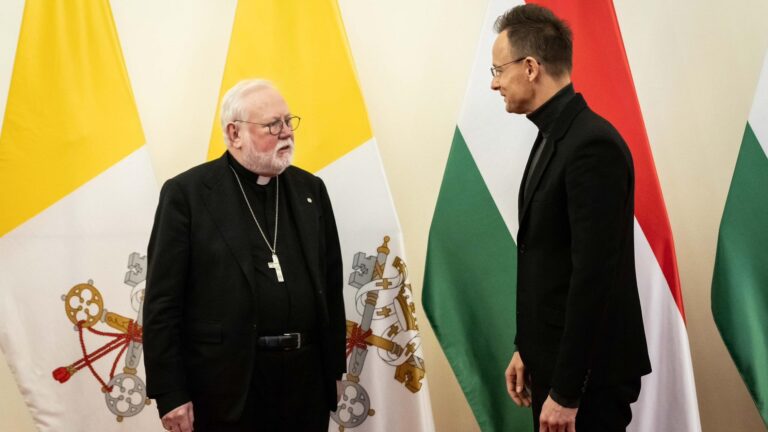As part of a joint exercise named ‘Vigilant Guardians’, the KFOR Tactical Reserve Battalion, composed of Hungarian and Romanian soldiers, and the Multinational Specialized Unit carried out crowd management tasks in Kosovo, Hungarian military news website Honvedelem.hu reported. Maintaining the fragile security balance of the country requires the NATO-led Kosovo peacekeeping forces (KFOR) to perform continuous joint operations, demonstrating a commanding presence in sensitive situations.
According to the scenario of the exercise held at the KFOR camp in Novo Selo, peaceful and less peaceful protesters approached from all directions. Initially, there was only minor commotion, but it soon escalated to shouting, shield-banging, and provocations. The Italian soldiers of the Multinational Specialized Unit (MSU), responsible for patrols and peacekeeping in real-life scenarios, formed the front line. Following the protocol, they endured the provocations with composure and discipline.
As tensions heightened, the Tactical Reserve Battalion (KTRBN) was alerted and quickly deployed a platoon to support the Italian forces. Chaos erupted: Molotov cocktails were thrown at the front line, followed by water bottles and sticks. Strength clashed against strength as paintball rounds rained down, batons were drawn, and shields were contested. Following the confrontation, the most unruly protesters were detained. As in real operations, the detainees were searched for sharp objects, explosives, and weapons by the Italian soldiers of the KFOR Multinational Military Police unit. They were then documented medically and taken into custody.
„Vigilant Guardians” – Erők kölcsönhatása
Közös gyakorlat keretében együtt hajtott végre tömegkezelési feladatokat Koszovóban a magyar és román katonákból álló KFOR Harcászati Tartalék Zászlóalj és a Többnemzeti Különleges Egység. Az ország törékeny biztonsági egyensúlyának megtartásához nélkülözhetetlen, hogy a NATO vezetésű koszovói békefenntartó erők (KFOR) katonái folyamatosan végezzenek közös műveleteket és együttműködésük eredményeképpen tekintélyt parancsoló erőt mutassanak egy-egy érzékeny helyzet során.
The Tactical Psyops Team (TPT), specializing in psychological operations, played a vital role in the exercise. They broadcast KFOR commander-approved messages over loudspeakers during every crowd management scenario, including this drill. Over the three-hour exercise, commanders coordinated and directed the multinational crowd control teams.
‘During the planning phase, I emphasized the importance of keeping the actions of the role players unpredictable, forcing participants and leaders to react to unexpected situations and make decisions accordingly,’ explained Lieutenant Colonel Tibor Dancs, commander of the 31st rotation of the Hungarian KFOR contingent. ‘The most crucial aspect during execution is cooperation with the international units. We need to learn how to manoeuvre together, align our command systems, understand the procedures of the international units present, and adapt ours accordingly,’ he added.

Hungarian soldiers serving in KFOR took on various roles during the exercise. Corporal Gergő Attila Ungvári, a machine gunner, stood in the front line with a shield. ‘This is the best position one can get because we see the most action here. It’s the most intense,’ he said, adding that he had positive experiences working alongside Romanian and Italian colleagues.
Sergeant Mónika Viszlóczki, a personnel officer, had the role to imitate the protesting crowd with her teammates. ‘I love it that in addition to my usual tasks in KFOR, I also receive such unique assignments. I thoroughly enjoy the exercises,’ she remarked. Corporal Márk Mező participated in the exercise as a grenadier. ‘My task was to deploy tear gas grenades if the crowd became unmanageable,’ he explained.
The use of non-lethal weapons is common in crowd management exercises, as KFOR’s mission is peacekeeping, ensuring a safe environment and freedom of movement for the local population. ‘One of the key lessons of the exercise is that no situation is predetermined. Soldiers must respond to diverse scenarios with discipline, as every soldier is responsible not only for themselves but also for their comrades and the entire community,’ summarized Lieutenant Colonel Tibor Dancs.
Hungary in KFOR
Hungarian soldiers have been integral to the NATO-led Kosovo Force (KFOR) since its inception in 1999, contributing to regional stability and security. As of June 2024, Hungary contributes 433 troops to the NATO-led Kosovo Force (KFOR), which has a total strength of 4,490 personnel from 28 contributing nations. In September 2024, the 31st rotation of the Hungarian Defence Forces’ KFOR contingent commenced its six-month service, continuing Hungary’s longstanding commitment to peacekeeping operations in the region. In October 2021, Major General Ferenc Kajári became the first Hungarian officer to assume command of KFOR for 12 months.
Hungarian forces have been stationed at Camp Novo Selo, operating primarily within the Tactical Reserve Battalion (KTRBN), specializing in crowd control, patrolling, and quick reaction tasks. Known for their professionalism and adaptability, Hungarian troops are frequently praised for their ability to cooperate with diverse units, seamlessly integrating into joint operations with soldiers from other nations. Through their efforts, they contribute not only to regional stability but also to Hungary’s reputation as a reliable partner in international peacekeeping. Their participation in KFOR highlights their commitment to fostering security, understanding cultural differences, and responding effectively to complex challenges on the ground.
Related articles:








